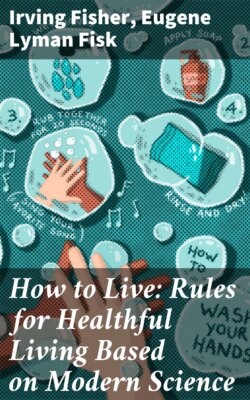Читать книгу How to Live: Rules for Healthful Living Based on Modern Science - Irving Fisher - Страница 30
На сайте Литреса книга снята с продажи.
Section V—Deep Breathing
ОглавлениеTable of Contents
Ordinarily breathing should be unconscious, but every day deep breathing exercises should be employed. “A hundred deep breaths a day” is one physician’s recipe for avoiding tuberculosis. A Russian author, who suffered a nervous breakdown, found—after trying many other aids to health without success—that a retired life for several months in the mountains in which simple deep-breathing exercises practised systematically every day formed the central theme, effected a permanent cure. Deep breathing is a great resource for people who are shut in most of the day. If they will seize the chance, whenever it offers, to step out-of-doors and take a dozen deep breaths, they can partly compensate for the evils of indoor living.
In ordinary breathing only about 10 per cent. of the lung contents is changed at each breath. In deep breathing a much larger percentage is changed, the whole lung is forced into action, and the circulation of the blood in the abdomen is more efficiently maintained, thus equalizing the circulation throughout the body. The blood-pressure is also favorably influenced, especially where increased pressure is due to nervous or emotional causes.
Breathing Exercises
Breathing exercises should be deep, slow, rhythmic, and through the nose, not through the mouth. A certain Oriental deep-breathing exercise is particularly valuable to insure slowness and evenness of the breath. It consists of pressing a finger on the side of the nose, so as to close one nostril, breathing in through the other nostril, breathing out of the first nostril in the same manner and then reversing the process. Attention to the slight sound of the air, as it passes through the nose, enables one to know whether the breathing is regular or is slightly irregular. Such breathing exercises can be taken at the rate of three breaths per minute, and the rate gradually reduced until it is only two or even less per minute.
Muscular Exercise
Muscular exercises stimulate deep breathing, and, in general, the two should go together. But deep breathing by itself is also beneficial, if very slow. Forced rapid breathing is comparatively valueless, and indeed may be positively harmful. Oxygen is absorbed only according to the demand for it in the body and not according to the supply.
Singing
Singing requires deep breathing, and is for that and other reasons an excellent hygienic practise.
Mental State
The mode of our breathing is closely related to our mental condition; either influences the other. Agitation makes us catch our breath, and sadness makes us sigh. Conversely, slow, even breathing calms mental agitation. It is not without reason that, in the East, breathing exercises are used as a means of cultivating mental poise and as an aid to religious life.
